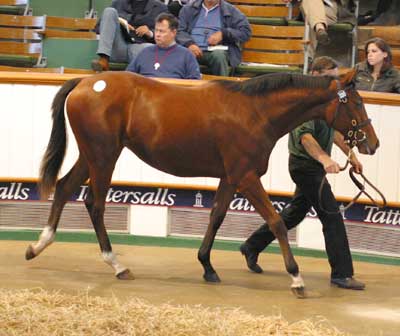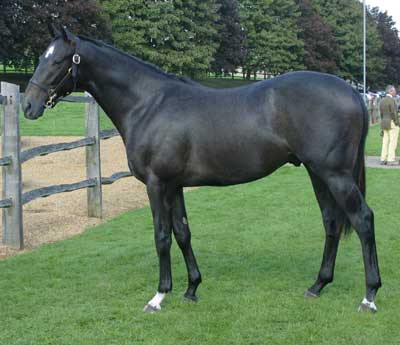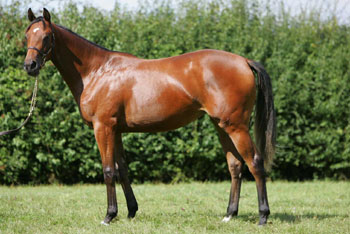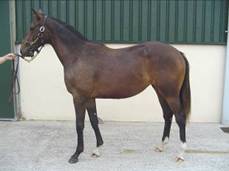



| << Discussion Home |
It's late May but early morning on the gallops of a southern training stables. The 2yos have been broken, taken through their basic drills, then developed muscle and fitness with weeks of trotting and then cantering. They are being put through some faster work in pairs and trios and the trainer is going to find out a great deal about what level of ability the individuals actually have.
The last pair are trundling towards you and the larger of the two is lagging by 5 lengths and looking more of a 'safe conveyance' than a racehorse. He's lovely to look at and has been a pleasure to train so far. He is the first horse for the owner whom you had visions of taking to the owner to the sales later in the year to buy some more expensive yearlings. Hmm, this could be a tricky one, time to start getting our story straight. The trainer turns to his assistant and says "Just remind me again, how much........".
Let us go back to October of the previous year and we are at the Tattersalls Sales. Thousands of yearlings across three sales, limited time to view them, the trainer and his agent resort to shortlists and easy answers. That big trundler looked fine, quite nice in fact, and the owner got right into the spirit of the bidding. He paid a bit more than we expected but was happy enough although he seemed to think he had bought a certainty given the recommendation from experts. He's now the owner of a labouring lummox but doesn't know it yet.
So far a story that happens hundreds of times a year across the country at all levels of spending. For every sales buy that meets, or occasionally exceeds expectations, there are rows of disappointments and failures. If the filing clerk, plasterer or middle manager made as many gaffs as the bloodstock agent in their daily routine they would be looking for a new occupation. But, like football and medicine, the normal rules do not apply here.
If you have ever been to the yearling sales you will be aware how tedious and disorienting they can be. The concentration and planning required to get through them is high. Consider a sale with 1,100 yearlings sold over 5 days at a rate of about 22 per hour. That will mean ten hour days of just auctioneers selling the horses and the agent will need to have inspected the horses before they are sold. They may have the previous day to review the horses or perhaps just a morning. The horses will be spread over a few acres and with walking time the yearling review is going to be notably brief.
Therefore, we have experts implementing an inexact procedure, involving a lot of guesswork and with too little time. This pressure is probably not a huge problem for the experts because if they had endless time to review the yearlings the results would not be much different. The framework to assess the yearlings more fully in terms of their athletic futures is simply not there.
If we take the example of a trainer with a biggish stable, not top rank but well above average, and look at his Sales Catalogue we will see blank pages with the occasional one annotated with "Nice" or "Big. Nice". They are the ones he is bidding for. I would not want too much jargon from my bloodstock agent but I would baulk at "Nice".
Now, a lot of preparation for the sales is done through looking at the pedigree and a lot of the writing in the Catalogues are actually notes on this. It is fascinating to watch bidders when the price has got to the high end of their range. While pondering whether to bid again they will look at the Catalogue page rather than the horse. They might be looking at very detailed notes of the horse, or perhaps to see whether they included "Really" before "Nice", but probably they are looking at their pedigree notes. It may just be a nervous response of course but that wouldn't be an improvement. You could get the feeling that that this is all a large, extended 'Poker Game' but without the rules and with no-one sure what a 'winning hand' actually looks like.
Going to the sales as an observer can be equally mind-numbing. It is best to go with a plan of what you want to get out of visit because the endless conveyor belt of horses, the auctioneer rattling away over the tannoy and the mysterious bids he seems to get from nowhere will soon have you baffled. Even for those with experience the mind can drift onto other matters... Why are the men that sweep up the manure all under 5ft? Inconspicuousness? I know why they get the tiniest lass to lead the smallest yearlings around. It is so it does not look as if the lad is taking his dog for a walk which wouldn't be good for the sale. Are titled people walking about in jeans and baseball caps a good or bad thing? Are they showing that they aren't aloof and can mingle? On the other hand if they are 'just one of us' why are we bothering with titles? The etiquette of advisor and flunky positioning is always an interesting one... but come on, concentrate on the matter in hand.
Try this question instead - you have sat and watched yearlings sold for prices between 10,000 to 1 Million guineas, what made the difference? To try to get a grip on the issue we shall use this simple formula :-
WEIGHT x DESIRABILITY = SALES PRICE
Weight is something we can deal with easily. At any level of sales price the bigger build the yearling has and the more muscular it is the better price it will make. You could line up 10 yearlings with the same 'Desirability' from heaviest to lightest and the prices they made would go from highest to lowest in good agreement. The preference for strong builds links to the concept of 'scope' - to develop with time and training. This preference will over-ride problems such as the sheer bulk of the yearling affecting its ability to carry the weight and therefore its athleticism.
Why 'Weight' and not 'Size' as well? Purchasers are willing to accept small yearlings and so long as they are not 'ponies' the price will not be particularly affected. The buyers expect that the yearling will grow to some extent and can make some sort of case that winners come in a range of sizes. In this context 'Correctness' is much more important than 'Size' which brings us to normal Paddock Review methods and to start unravelling the factors that make up 'Desirability'.
In a simplistic view the major factor which makes up the sales price due to 'Desirability' ought to be how good a physical specimen the yearling is. For example, if you treated the Sales Review as the same as a Paddock Review (as covered on this site) you should come up with a rating for the yearling as a athlete. This number would, in theory, be a prime part of the sales price. However, this only works in a small range of sales prices between about 1,000 and, say, 30,000 guineas. The scale is non-linear and once the price starts climbing above this range a raft of other factor start affecting the price.
To make the point B2yoR produces its own 'Value' figures for yearlings seen at the sales. These are produced by dividing the price by the rating given. The output is a value figure which is how many 1,000 guineas had to be paid for that yearling per rating point. At the lowest levels the figures show some relationship to price (between value ratings between 50 to 250) but the figures soon take off above 1,000 with the highest (worst?) value figure being 6,722. The link between physical specimen and price has been reduced to little more than noise in the actual sales price paid. Other factors have become much more important and we need to consider what they are.
We can also use normal performance ratings to confirm the same point. If a yearling is bought for 30,000 guineas, is capable of rating 90 at both two to three years old, wins 5 races and £40,000 in prize money then it is solid value even though it won't have paid for itself (depending upon what resale value it has). If we then consider a horse that cost 300,000 guineas it clearly cannot be rated 10 times better, if it gets rated 33% better at 120 it would be remarkable.
The majority of horses that cost high prices do not win or do so at a ordinary level so that 1000% hike in price from the 30,000 runner is actually a gamble on trying to find a top class horse and nothing to do with physical capabilities as such. Not a game to get involved in unless you can buy lots of expensive yearlings to try to find the good one. It is interesting to consider Godolphin in this context. Despite the tens of Millions they spend on the best yearlings each year how many top class horses does that group actually produce for them? If it were really successful would they be spending quite so much buying proven two and three year olds from other sources?
Let us turn to 'Desirability' again and to the range of more nebulous factors which contribute to the sales price, especially in inflating the highest prices. In no particular order here are some of them which will be explained below :-
Very rarely this approach works but 2005 gave a good example. The broodmare Star cost 16,000 guineas at the sales and was an average winner. She visited average sires and her first foal made 2,000 guineas at the sales and was a poor runner. The next foal cost 24,000 guineas and when named Pastoral Pursuits became a Group 3 winner at 2yo and Group 1 at 4yo. His success at 2yo convinced Sheikh Mohammed to pay 110,000 guineas for the next foal and an example of how the prices escalate when bigger owners start taking an interest in pedigrees they would normally avoid. That runner was Goodricke who showed useful form at 2yo without looking high class but became a Group 1 winner at 3yo (which possibly tells us a lot about the overall quality of the sprinters we currently have).
GOLDEN GOOSE - at yearling sales purchasers are willing to pay high prices for individuals by top sires out of well related mares. The mare may have moderate to poor race form or possibly unraced. She may have produced no previous foals or possibly a small number that have shown average winning form at very best. This wont matter so long as she is well enough related and from a fashionable female 'family'. The yearlings from her will still sell for hundreds of thousands of guineas. This does not make sense but that is not the point. Although it is mangling the fairytale a little we'll call such a broodmare a 'Golden Goose'.
When a filly comes up at the sales with this sort of pedigree background the price paid will have no relation to her physical make up. It will reflect her ability to become a Golden Goose herself when she starts breeding. If she can win some sort of race all the better and better still if she can blag a place in a weak Listed Race which will get her printed in bold type in the Sales Catalogue. If she's very slow then probably best to leave her unraced so no-one sees her prove it.
STALLION'S MIDAS TOUCH - a good stallion will have an outstanding season from time to time and will get a reputation of being able to produce results from any mare and with any physical type. When this happens the bidding for their yearlings will start from a higher base and the prices will go up markedly. This will reflect the 'hype' and the fact that the buyers want an 'easy answer' that they cannot be blamed for. The many times champion sire Sadler's Wells has long produced sales prices out of proportion to the actual returns the average runner can expect.
A more recent example has been Pivotal who has gained a huge reputation and his yearlings made notably high prices in 2004 because of the competition to get one. Have a look through the sales prices and results for his 2yos in 2005 on this site to get an idea. The yearling sales prices in 2005 went even higher despite the moderate results with the expensive and well bred 2yos in 2005. His average yearling price in 2005 is well over 100,000, consider how it is possible for the vast majority of these to recoup that kind of money through their racecourse performances.
SUPPORT YOUR LOCAL STALLION - this really refers to Coolmore (J Magnier, M Tabor, JP McManus & co) and Godolphin. Each year they will have a number of first season stallions that raced for them and are now tasked with being the money generators for the stud. The big organisations want their sires to get off to a good start at the sales which will be good publicity for their futures. Coolmore and Godolphin will therefore be active in buying a range of yearlings by their sires.
At the lower level these may be natural 2yos that they can give to particular trainers to ensure early runners for their new sire. At the higher level they need to be seen bidding for, and buying a few of, their sire's best individuals. They need to show they are supporting their sires as well as wanting to buy potential stallions as well. This pump-priming drives prices up in general.
STALLION'S PEDIGREE - a good physical individual with a solid pedigree by a fashionable sire will make a good price. If his pedigree can be classed as a 'Stallion's Pedigree' than the price can double, triple, who knows. This means he will be by a sire with a proven record for producing high class runners and potential sires and will also have a very high class dam pedigree. Ideally she ought to be very well related and have been a high class runner herself. This requirement can bypassed if the dam has already produced a Group 2 winner or better.
For example, have a look through the first season sires for 2006 table and check out the dams of those sires and see how many of them you recognise as high class runner and/or producers of high class winners. In general in horseracing we focus too much on the sire's influence and forget that the dam's input of genetic material is 50% at least.
COMPETITIVE BIDDING - it takes two to tango, and at least two for a punch up. Prices will get pushed to unrealistic levels if more than one well funded group are set against others. It is worth remembering that the majority of these groups will be working off the same shortlists, pedigree fashions, etc. so that they often become hooked up on a limited set of select yearlings and drive the prices paid up.
THE SAFE SOLUTION - in the computer business there used to be a phrase that went "no-one ever got sacked buying IBM". This indicated that although the products were not necessarily the best, nor the most lively but they would work and the size and backing of IBM company would ensure you got a positive result. The products were usually of premium price. The 'Safe Solution' refers to the very small number of yearlings in each year that have no obvious negatives - good pedigree, good physically, fashionable, etc. This will combine to ensure the highest level of desirability and the highest prices (and realistically being purchased by Godolphin or Coolmore in most European sales and to a large extent the US sales as well).
PEDIGREE ANALYSIS FASHION - a big subject and outside the scope of this article to more than scratch the surface. It is worth noting that in the absence of any proper understanding of the inheritance of athletic ability in thoroughbreds (or humans come to that) that any 'Pedigree Analysis' really amounts to what is in fashion rather than proven. However, the latest fashion has a real impact on the prices paid for yearlings through improving their desirability. Also, because there is so much guesswork involved in buying yearlings the ability to talk about nicks, crosses, inbreeding, dosage, three-quarter brothers in blood, etc. is useful to add a veneer of inside knowledge.
In this area it is interesting to consider the metamorphosis of bloodstock writer Tony Morris over a 40 year career. He can write a classic pedigree piece covering any of the fashionable points but over recent years has made it clear that he has come to doubt that most, if not all of them, are not actually based on scientific foundations. A subject we shall return to in a later article.
To realise how nebulous the concept of Value can be then a visit to the 'Horses In Training' sales is recommended - but take along a listing of how much the horses on offer cost at the sales as foals, yearlings and 2yos. Depending upon your view you might find this type of sales poignant (all those dreams, high hopes & positive words proved worthless), funny (enjoying other's misfortunes) or perhaps just baffling. All those expensive horses selling for fractions of their earlier prices. Ah, but buying racehorses is an art, and there are no guarantees. Any top level Bloodstock Agent has wasted more rich people's money than you will earn in your lifetime.
To end try this version of the 'Virtual Paddock' to see how the link between physical type and sales price can be disrupted by other factors. The other Virtual Paddocks on this site are designed to show how physical type is linked to actual performance rating a horse achieves. This version is more difficult because the pictures show yearlings of 2005 that have not run and the link is to the actual sales price paid. Consider the following four sales prices and descriptions and try to match them to the pictures below.
 |
 |
 |
 |
UPDATE - January 2007
None of the four yearlings of 2005 pictured in the article ran as 2yos during 2006. For information the yearlings are :-
TOP LEFT = JAMBORETTA (Danehill ex Jiving, cost 575,000gns), owned
by Cheveley Park Stud and in training with M. Stoute. [Nov 2010 Update = won a maiden and a handicap off OR86. Tried in a Group 3 and listed races through to September of her 4yo season. Well beaten in those and finished with an official rating just over OR90.]
TOP RIGHT = BOLD GLANCE (Kingmambo ex Last Second, cost 1.25 Million
guineas), owned by Godolphin and in training with SB Suroor. [Won his first run at 3yo in a maiden. Beaten in later runs off OR ratings in the low to mid-80s. Raced in Dubai at 5-6yo off OR82 without success.]
BOTTOM LEFT = LOVEALOT (Fraam ex Lovealoch, cost 120,000gns), half
sister to Flashy Wings and a number of non-entities. In training with RM
Beckett for Tweenhills Racing. [Nov 2010 Update = unraced.]
BOTTOM RIGHT = [Un-named] (Sakhee ex Dodo, cost 260,000gns), bought
by J Ferguson (Darley's agent) and not listed in training. [Nov 2010 Update = unraced.]